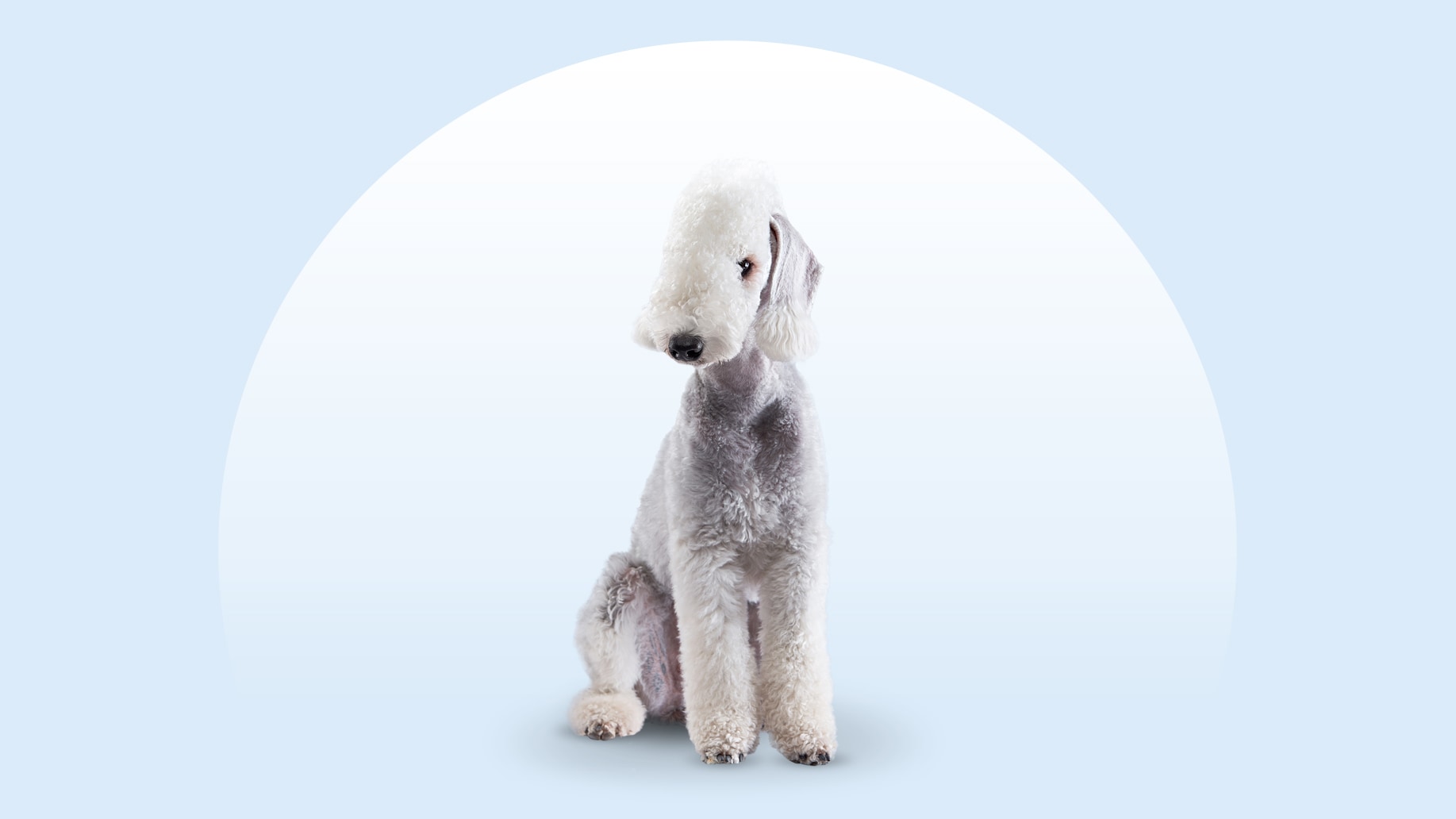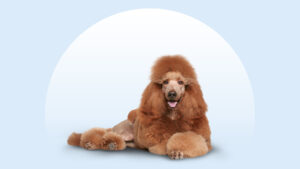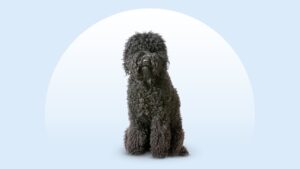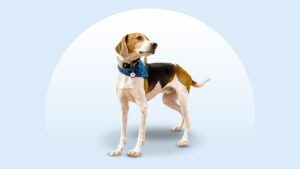Bedlington Terrier
Updated May 5, 2025
Bedlington Terrier
Updated May 5, 2025
No, that's not a little lamb—it's the Bedlington Terrier, an affectionate and social dog who loves being the center of attention. They're a great pup for pet parents willing to devote extra time to grooming those fluffy coats, as well as regular exercise and training.
Social Butterfly, Inquisitive, Quick
Male: 17-23 pounds
Female: 17-23 pounds
Male: 15-17.5 inches
Female: 15-17.5 inches
11 to 16 years
Blue, Sandy, Liver, Sandy and Tan, Liver and Tan, Blue and Tan
Ever dreamed of caring for a lamb? You’re in luck—Bedlington Terriers are dogs in lambs’ clothing. They’re just as sweet as the wooly farm animals, and they look like them, too. Even better, they’re amazing companions; they’re happy to help introduce you to new people in your neighborhood or even finish a puzzle alongside you—Bedlingtons love to solve a good thinker. At the end of the day, a Beddie is always ready for a debrief about your adventures together and already looking forward to tomorrow’s.
Bedlington Terrier Characteristics
Bedlington Terrier Appearance
Light-colored Bedlington Terrier dogs are commonly mistaken for lambs, but these pups come in a range of colors. With their arched backs and thin tails, these dogs have a striking appearance. Their expressive, almond-shaped eyes will beg you to play with them, and they’re happy for a good scratch on their soft, flappy ears after a day spent with their favorite human.
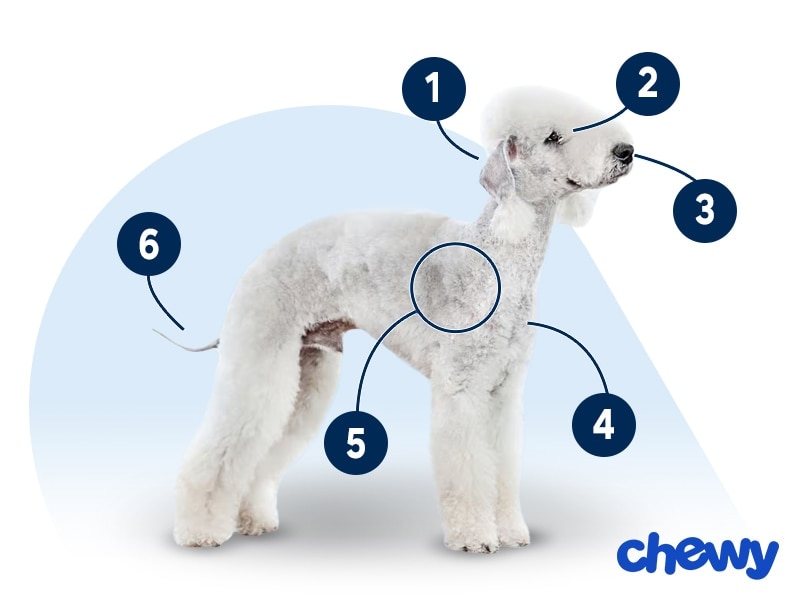
- Ears
The Bedlington Terrier's ears are thin, fuzzy flaps that are often curly. They hang close to the head with a soft rounded bottom of fringe that reaches their jaw or hangs slightly past it.
- Eyes
A Bedlington Terrier's eyes may be dark (if they have a blue coat), amber (blue and tan coat), hazel (liver or liver and tan coats) or light hazel (sandy or sandy and tan coats). Their eyes are also rimmed in black or brown, depending on their coloring.
- Nose
A Bedlington Terrier's nose coloring is also dependent on coat color. It's either black in blue and tan dogs or brown in sandy, liver and bi-colored tan dogs.
- Coat Length
The Bedlington Terrier's double coat is thick, curly and medium in length, about one inch on the body and slightly longer on the legs. (A dog with a double coat has two layers of coats: The undercoat is typically dense and more "wooly" and regulates body temperature. The top coat is longer and repels dirt and water.)
- Coat Color
The Bedlington Terrier's coat can be tan, blue, sandy, liver (a grayish brown) or combos like blue and tan or sandy and tan.
- Tail
The Bedlington's tail is low-set, thin and rope-like. It's lengthy and comes to a point at the tip.
Bedlington Terrier Temperament
The Bedlington Terrier has a playful, opinionated personality, and a confident springy gait that is often at home in the show ring. Beddies would be elected class clown if such awards were given out in dog school; they adore performing tricks and will keep you in stitches with pranks like playing peek-a-boo around a corner or hiding under blankets until you find them.
The Bedlington loves to be the center of attention, and does particularly well with active pet parents or a family with kids to run around with on a daily basis. This smart, inquisitive and typically easy-to-train breed will pay you back in kisses and cuddles after every outing.
The Bedlington Terrier breed has been known to nip or react when their paw is stepped on or their rope-like tail gets tugged. Bedlingtons like everyone, but are better suited to families with kids who have been taught how to play gently with a pup and not pull the dog’s fur or tail. Young kids will need to be taught good dog manners for playing with the Bedlington (and vice versa). Bedlingtons may also do well with a companion kitty if raised with one since puppyhood, but outdoor cats, beware: The breed was bred to hunt critters, giving them a high prey drive that sets them on a chase when cats, bunnies or other small woodland creatures are spotted outdoors.
Bedlingtons are a friendly, social little working dog breed. (Working dogs are pups who were bred to do a job, like herd sheep or guard estates). In addition to hunting vermin, Beddies were also bred to be bait in pit fights, so while they won’t start a rumble, they won’t back down easily either. Still, with proper socialization and training Bedlingtons can do well with other dogs in the house.
How to Care for a Bedlington Terrier
Bedlington Terriers rank high on the personality charts; thankfully, their care is more toward the middle end of the scale. While their coats require a lot of maintenance (that haircut!), their exercise and training needs are moderate. Plan to spend about an hour every day exercising and playing with your pup. And because these pups are eager to please you, you’ll find they’re relatively easy to train.
Grooming
Training
Diet
Exercise
Environment
Bedlington Terrier Health
Bedlington Terriers have a life expectancy of 11 to 16 years, but they do have a few health problems to look out for. Knowing the problems associated with this breed can help you keep your Bedlington Terrier in excellent health and make sure you purchase a pup who’s had the right health screenings.
- Copper Storage Disease: This disease, caused by a mutant gene that prevents normal copper excretion in the liver and resulting in chronic hepatitis, is acquired from the parents. The disease has been successfully reduced by genetic testing and not breeding dogs with the gene. Make sure the parents of the puppy you want have been tested for the genetic marker. Treatment can include medication and a change in diet.
- Retinal Dysplasia: Present from birth, retinal dysplasia is an eye problem where the formation of the retina is disrupted, causing blindness. Breeders often notice at 3- to 4-weeks of age when a Bedlington Terrier puppy is less active than their littermates. There is no treatment for the disease, but there are genetic screening tests available.
- Distichiasis: A condition caused by extra hairs that grow inside the pup’s eyelid and rub the surface of their eye, distichiasis is commonly inherited and can cause painful corneal ulcers. Treatments are available including removing the hairs and surgery in severe cases.
- Hip and Elbow Dysplasia: Joint dysplasia occurs when the joints don’t form correctly, causing them to be loose. This can be painful and result in arthritis. Treatment includes joint supplements, pain medication, weight management, and surgery in severe cases.
- Luxating Patella: Luxating patella is a condition in which the kneecap can pop out of place, resulting in limping, pain and arthritis. While there is likely a genetic component to luxating patella, there is not currently a genetic screening test for this condition. Dogs with luxating patella should not be bred. Treatment typically includes weight maintenance and joint supplements, but severe cases may need surgery.
- Bleeding Disorders: Bedlington Terriers are prone to bleeding disorders involving trouble clotting, such as von Willebrand’s disease and thrombocytopenia. Blood tests can be done to diagnose these conditions. Your vet may recommend medications or, if your pet is having surgery, they may need to have a blood transfusion as part of the procedure.
Bedlington Terrier History
The Bedlington Terrier originated in the town of Bedlington in Northumberland, England, and was bred to hunt vermin like weasels and polecats, as well as to flush rats from the coal mines, which accounts for their high-prey drive. Sadly, they were also used as bait in pit fights, which is why they are reluctant to back down from another dog.
The Lord of Rothbury became fond of the little lamb-like breed, and they later became known as the Rothbury’s Lamb or Rothbury’s Terrier. The breed was recognized by the American Kennel Club in 1886 and is the club’s 25th breed. The Bedlington shares traits of the Whippet, Kerry Blue and Soft-Coated Wheaten Terrier.
Are you looking to add a Bedlington Terrier as a family member? Generally, this type of puppy will cost between $1,800 and $2,300. Check out the AKC’s website to find a reputable breeder. You can also seek out local Bedlington Terrier rescues to find a worthy, loving dog to adopt or keep an eye out for the breed at your local animal shelter. Search Chewy’s network of adoptable dogs for Bedlington Terriers in your area.
FAQs
Are Bedlington Terriers hypoallergenic?
How long do Bedlington Terriers live?
What are the most common Bedlington Terrier mixes?
What were Bedlington Terriers bred for?
Are Bedlington Terriers good family dogs?
Do Bedlington Terriers bark a lot?
Expert input provided by Michelle Burch, DVM at Vestor and Russell Hartstein, CDBC, CPDT-KA, Fear Free Certified trainer and behaviorist at FunPawCare in Los Angeles.
Breed characteristic ratings provided by veterinarian Dr. Sarah J. Wooten, DVM, CVJ, a veterinarian at Sheep Draw Veterinary Hospital in Greeley, Colorado; dog trainer and behavior consultant Irith Bloom, CPDT-KSA, CBCC-KA, CDBC, owner of The Sophisticated Dog, LLC, in Los Angeles; and certified animal behavior consultant Amy Shojai, CABC, in Sherman, Texas.
The health content was medically reviewed by Chewy vets.
